Classic aromatic herbs like lavender and calendula offer both therapeutic benefits and appealing scents in handcrafted soaps. You'll create richly aromatic bars by incorporating ancient resins such as frankincense and myrrh, which provide natural antibacterial properties. For maximum fragrance, harvest herbs during peak season and properly dry them before infusion. Try blending essential oils like peppermint with tea tree or pairing sweet orange with rosemary for signature combinations. These timeless ingredients transform ordinary soap into extraordinary sensory experiences.
The Magic of Botanical Herbs in Traditional Soap Making
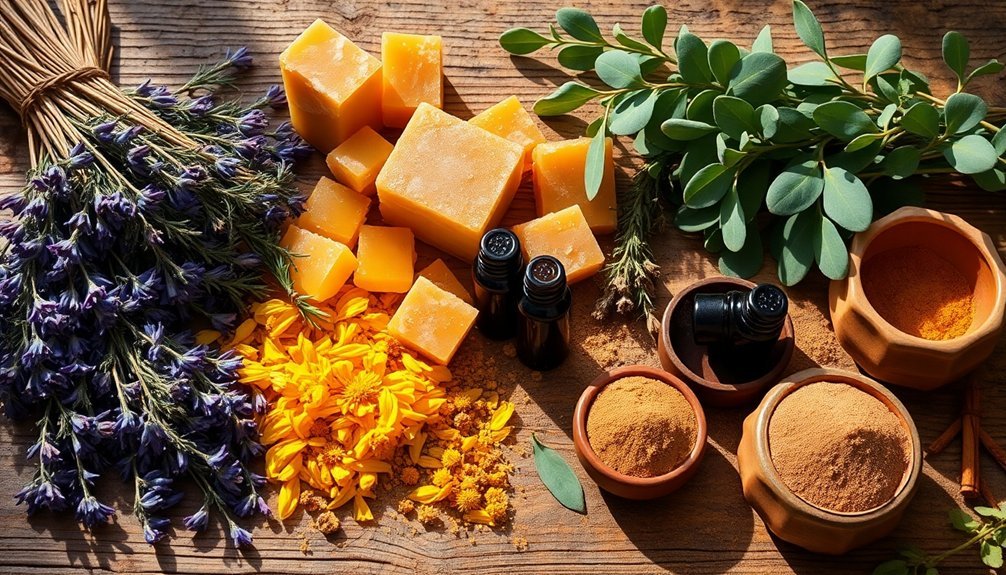
When you incorporate botanical herbs into your soap creations, you're not just making something that cleanses—you're crafting a sensory experience with centuries-old healing traditions.
Botanical herbs like calendula and lavender offer therapeutic benefits beyond visual appeal, including anti-inflammatory properties and calming effects. You'll find that infused oils carry the essence of these herbs, enhancing your natural soap with their therapeutic qualities.
Try adding exfoliating herbs such as lemon peel for texture and gentle scrubbing. The careful selection of aromatic herbs creates distinctive scent profiles that transform ordinary soap into something extraordinary.
Whether you're blending lavender essential oil with dried buds or experimenting with peppermint and eucalyptus, each herb brings its unique character to your soap, connecting your craft to ancient wisdom while delivering modern benefits.
Ancient Resins: Nature's Aromatic Treasures
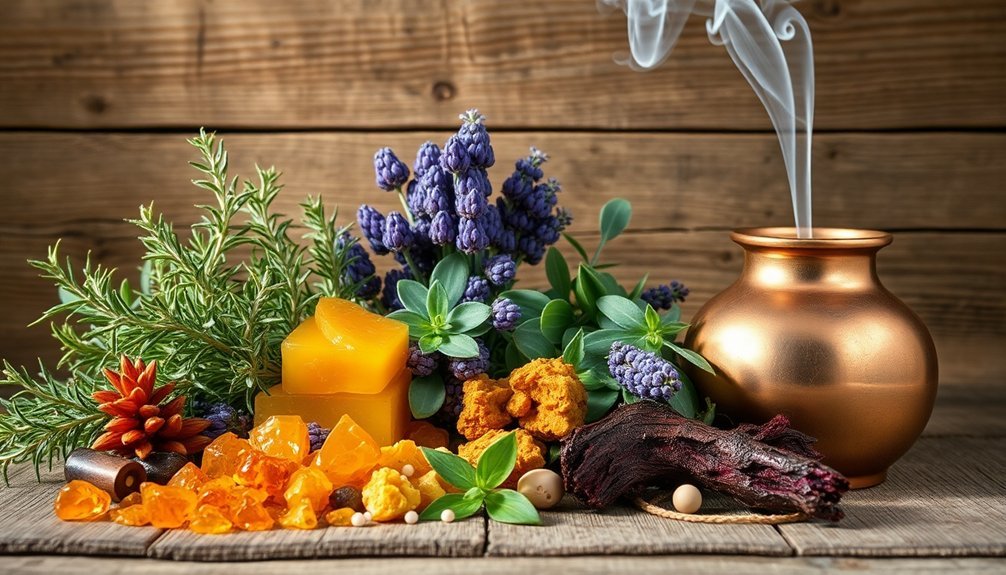
Though often overlooked in modern soapmaking, ancient resins represent some of nature's most precious aromatic treasures with histories spanning thousands of years.
Frankincense and myrrh, derived from tree sap, deliver rich aromatic properties while offering natural antibacterial benefits that ancient cultures prized for healing.
You'll find these resins contain complex blends of sugars, enzymes, and minerals that enhance your soap's therapeutic qualities.
For proper infusion, grind your chosen resin into powder and mix with carrier oils at a 4:1 ratio to extract their potent properties.
Don't forget lesser-known options like opoponax, which adds sweet myrrh notes that complement fragrance oils beautifully.
Beyond their enchanting aroma, resins contribute natural coloration and texture, transforming your handcrafted soaps into unique sensory experiences.
Essential Oil Blending for Classic Soap Formulations
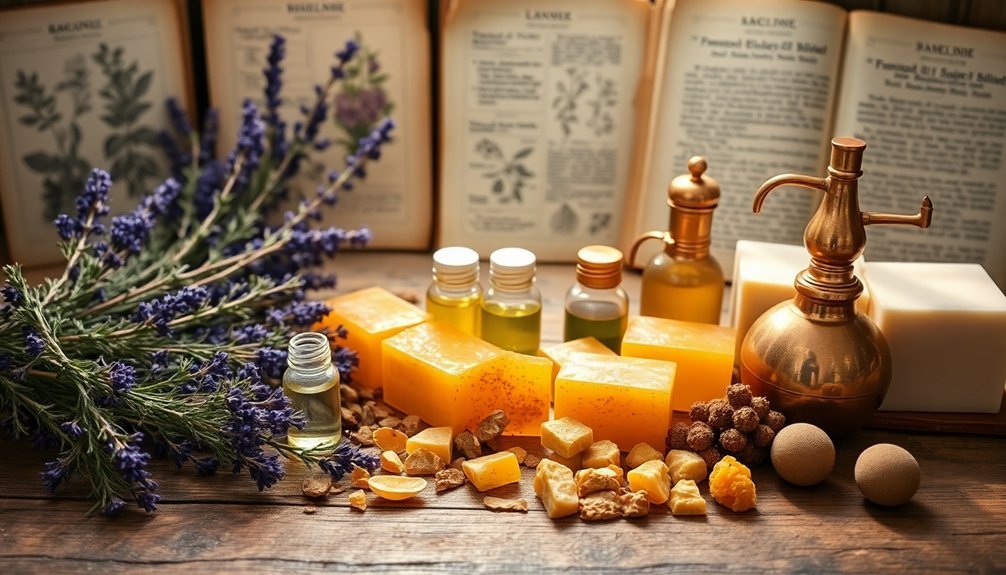
Because essential oils represent the heart and soul of artisanal soapmaking, mastering their blending techniques dramatically transforms your creations from simple cleansers to therapeutic experiences.
When crafting classic formulations, you'll find adding oils post-saponification in hot process methods preserves their fragrance profiles most effectively.
Try pairing lavender with orange blossom for an exquisite floral bouquet, or combine peppermint and tea tree for invigorating freshness. Citrus oils like sweet orange and grapefruit deliver uplifting qualities perfect for seasonal soaps.
Experiment with different ratios—this vital step determines your blend's uniqueness and longevity.
For complex scents that truly captivate, consider complementary combinations like patchouli with bergamot. These sophisticated pairings create distinctive aromatic signatures that elevate your soapmaking artistry beyond ordinary commercial products.
Harvesting and Preparing Herbs for Maximum Fragrance
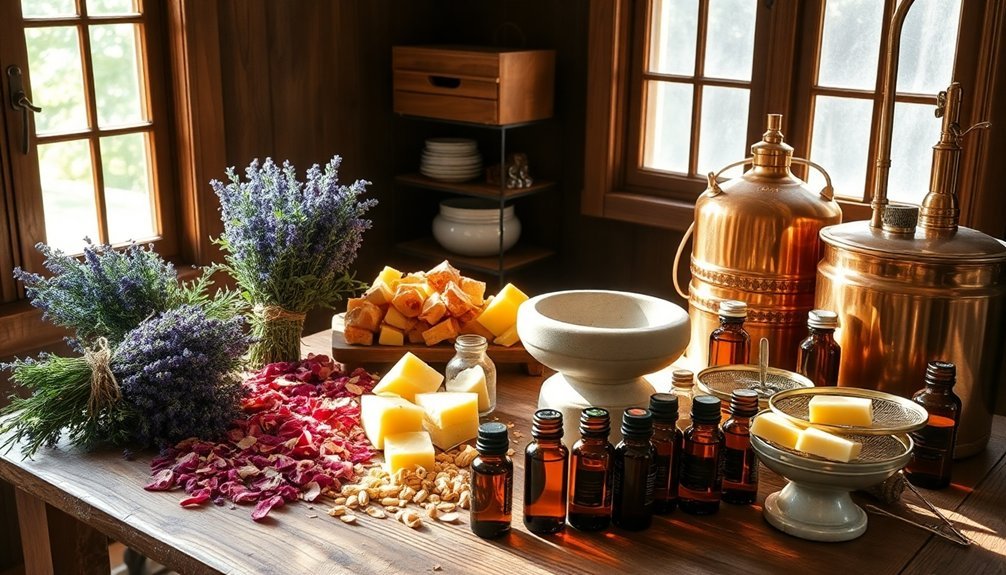
The vibrant aromatic qualities of herbs depend heavily on proper harvesting techniques and timing. You'll achieve maximum fragrance by harvesting herbs during peak growing season, preferably in the morning after dew has dried.
Use sharp scissors or pruning shears for clean cuts that preserve essential oils within the plant tissue.
To release aromatic compounds effectively, crush or chop your herbs before infusing oils for soapmaking. This increases surface area and allows better extraction of their natural fragrances.
Always dry herbs in a shaded, well-ventilated area to prevent degradation of their essential oils—direct sunlight and excessive heat diminish potency.
Once properly dried, store dried herbs in airtight containers away from light and moisture. This careful preservation guarantees your handcrafted soaps will benefit from the herbs' full aromatic potential.
Creating Signature Scent Combinations With Vintage Ingredients
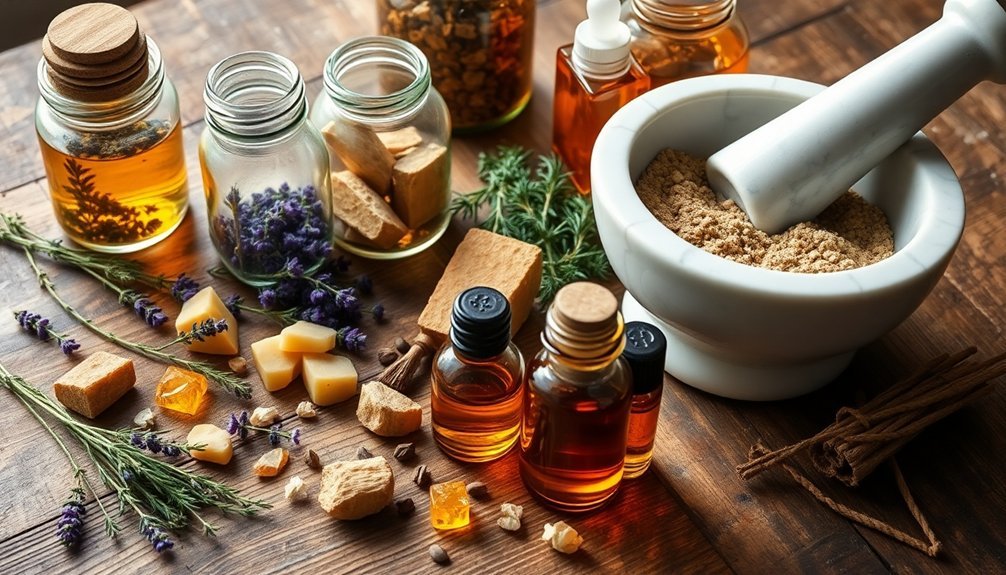
Ancient resins and traditional herbs offer soapmakers unparalleled opportunities to craft distinctive aromatic profiles with historical depth.
You'll find that vintage ingredients like frankincense and myrrh transform ordinary soaps into sensory experiences rich with cultural significance.
Try pairing lavender essential oil with sweet orange for a balanced blend that's both calming and uplifting. This timeless combination works beautifully with infused opoponax resin, which adds a sweet, balsamic undertone that complements both floral and citrus notes.
For visual appeal and soothing properties, incorporate chamomile and calendula into your herbal blends. These traditional botanicals enhance your signature scents while connecting to age-old wellness practices.
Rosemary with sweet orange creates another invigorating aromatic profile that elevates your handcrafted soaps beyond the ordinary.
Frequently Asked Questions
What Is the Best Herb for Soap Making?
The best herb for soap making depends on your needs. Lavender's versatile, with strong scent retention and relaxing aroma. You'll find it's ideal for various formulations, giving you reliable results every time.
What Dried Herbs Can You Put in Soap?
You can add lavender buds, calendula petals, chamomile flowers, eucalyptus leaves, lemongrass, and spearmint leaves to your soaps. They'll provide natural colors, textures, and scents while enhancing the sensory experience for users.
What Is the Best Plant to Make Soap?
The best plant for soapmaking depends on your goals. Lavender offers versatility with excellent scent retention, while calendula works beautifully for gentle soaps. You'll find eucalyptus invigorating and chamomile soothing for different soap varieties.
What Are the Best Dried Flowers for Soap Making?
For soap making, you'll find calendula petals, lavender buds, chamomile flowers, eucalyptus leaves, and spearmint leaves work best. They'll add beautiful colors, textures, and therapeutic benefits while maintaining their properties during the curing process.
In Summary
You've now discovered the timeless art of botanical soapmaking. By incorporating ancient resins, aromatic herbs, and essential oil blends, you're connecting with centuries of tradition while creating something uniquely yours. Don't be afraid to experiment with harvesting techniques and signature scent combinations. Your handcrafted soaps aren't just cleansing products—they're aromatic treasures that honor nature's gifts and your creative spirit.

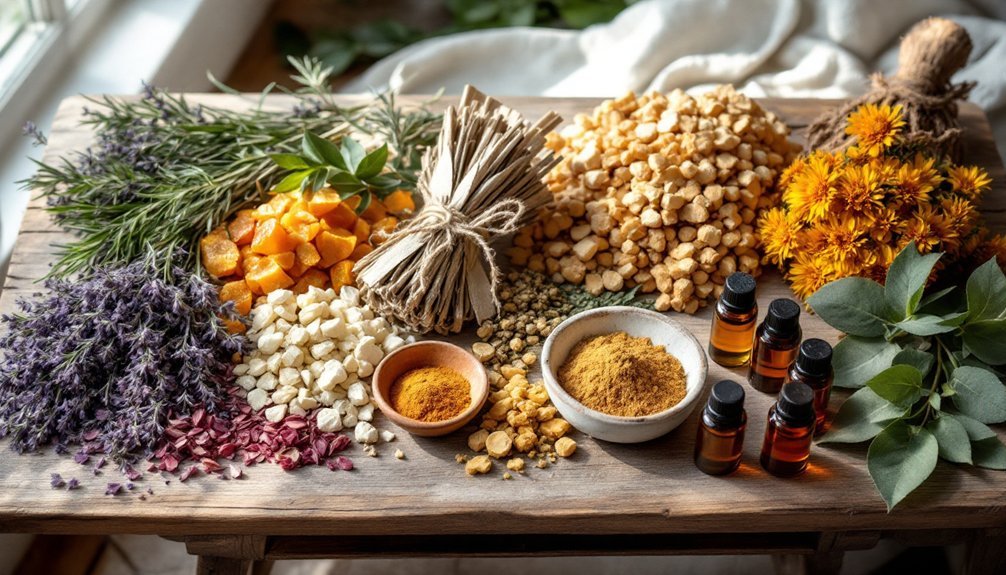



Leave a Reply